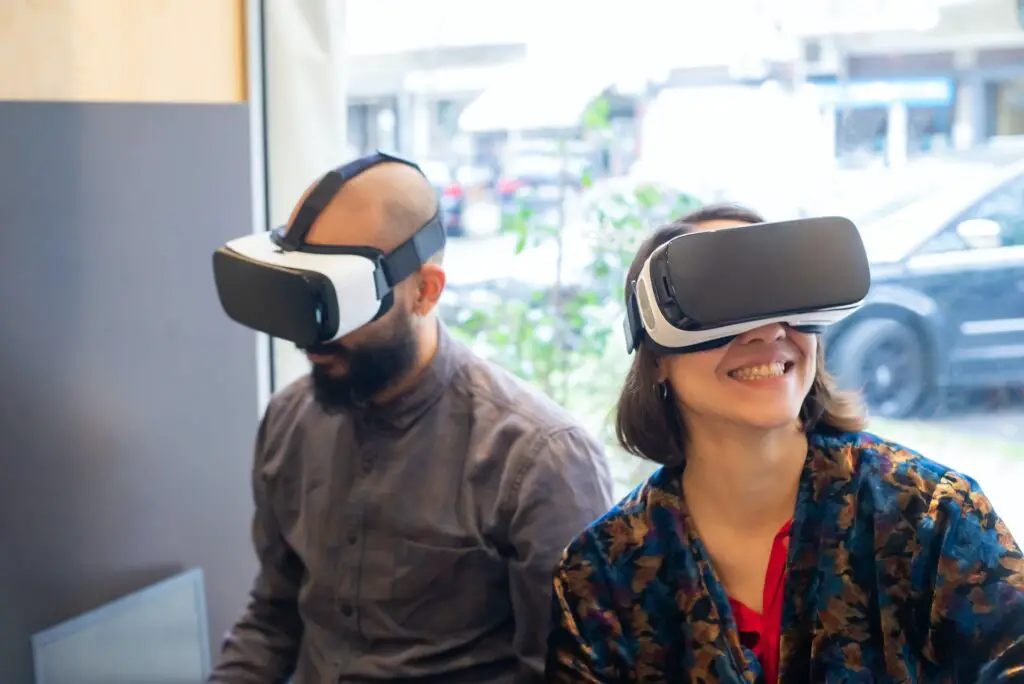Language learning has come a long way since the days of flipping through flashcards. And although I do love and appreciate the effectiveness of consistent flashcard use, advancements in technology, particularly Artificial Intelligence (AI) and Virtual Reality (VR), can dramatically change how we learn. In this post, we’ll explore the fascinating worlds of AI-powered language learning and language immersion at home with Virtual Reality.
The Role of AI in Language Learning
AI is quickly becoming an advantageous tool in language learning. It offers personalized and interactive experiences that adapt to individual learners’ needs revolutionizing several aspects of language learning, including:
Personalized Learning
It has always been natural for a real, live, (and human!) teacher to tailor lessons to a student’s skill level, learning style, and pace. But now, thanks to AI, language learning platforms can now do the same. This personalization ensures that even while using a computerized platform you stay engaged and motivated, which leads to better retention and faster progress. By recognizing which topics or skills you struggle with, AI algorithms provide resources and support to address those areas.
Natural Language Processing (NLP)
NLP enables AI systems to understand and interpret human language, making them a valuable resource for anyone learning a language.
AI-powered chatbots, for instance, can help you practice conversational skills in a low-pressure environment. These chatbots can simulate conversations, offer suggestions, and provide real-time corrections, mimicking the experience of talking to a native speaker.
Furthermore, advanced NLP techniques can analyze written text and provide insights into grammar and syntax, helping you improve your writing skills.

Speech Recognition and Feedback
AI systems can analyze a student’s speech pattern and provide feedback on pronunciation, tone, and fluency. This instant feedback allows the student to correct their mistakes and improve their speaking skills in real-time.
Gamification and Engagement
AI-driven platforms often incorporate gamification elements, such as points, levels, and rewards, in order to make learning more enjoyable and engaging. From over a decade of teaching experience, I can attest to the effectiveness of games and enjoyment in language studies.
In addition, by incorporating interactive games and quizzes that adapt to a learner’s skill level, AI-powered language learning platforms can turn the traditionally tedious process of memorizing vocabulary and grammar rules into a fun and engaging experience.
Monitoring and Assessment
AI technology can also keep tabs on your progress by analyzing data gathered from your interactions with the platform. As a result, AI algorithms can determine areas of strength and weakness, and help focus on what needs improvement.
Language Immersion at Home with Virtual Reality
While AI has brought significant improvements to language learning, adding VR immersion to the mix takes it to a new level.
VR technology creates a fully immersive, 3D environment that simulates real-life situations, enabling you to practice your language skills in context. Here’s how language immersion at home with VR enhances language learning:
Contextual Learning
One of the most significant challenges people face when learning a language is understanding and using newly acquired skills in real-life situations. VR provides the perfect platform for contextual learning, as it allows you to practice your language skills in a variety of scenarios, such as ordering food at a restaurant, asking for directions, or attending a business meeting.
Since VR enables you to interact with virtual characters and environments that mimic real-life situations, it helps you put your newly acquired skills into action.
Overcoming the Fear of Speaking
Almost everyone feels anxiety when first having to speak in their target language. It’s only natural. VR immersion provides a safe, controlled environment where you can practice speaking without the fear of being judged.
This freedom helps build confidence, and ultimately leads to better communication skills. Additionally, VR experiences can be easily customized to match your skill level, ensuring that you are challenged without becoming overwhelmed.
Cultural Immersion
Understanding the cultural nuances of a language can be extremely helpful for effective communication. VR can transport you to different parts of the world, enabling you to experience the culture and interact with virtual native speakers in a natural setting. This cultural exposure can help you develop a deeper understanding of the language in context.
Accelerated Learning
Several studies have shown that VR immersion can lead to faster language learning compared to traditional methods.
The immersive nature of VR promotes higher levels of engagement and motivation, helping students retain information better. Additionally, the multi-sensory learning experience provided by VR stirs various cognitive processes, such as memory, attention, and problem solving, which can further enhance learning outcomes.
Collaboration and Social Interaction
Since many VR language learning platforms offer multiplayer options, this can allow learners to interact with other users in a virtual environment. This feature fosters collaboration and provides opportunities for learners to practice their conversation skills with people from diverse cultural backgrounds.
Engaging in real-time communication with other language learners not only helps develop speaking and listening skills but also spurs learners to explore different perspectives and ideas.

Getting Started with Language Immersion at Home with Virtual Reality
Now that you know the benefits of language immersion at home with VR, you might be eager to give it a try. Here are a few steps to help you get started:
1. Choose the Right VR Hardware
To begin your VR immersion language learning journey, you’ll need a compatible VR headset. There are several options available, ranging from high-end devices like the Oculus Rift or HTC Vive to more affordable options like the Oculus Quest or Samsung Gear VR. Do some research and choose a headset that best fits your budget and needs.
2. Select a Virtual Reality Language Learning Platform
Once you have your VR headset, you’ll need to choose a language learning platform that supports VR immersion. Some popular options include Mondly, ImmerseMe, and FluentWorlds. Each platform has its unique features and offerings, so take the time to explore your options and select the one that aligns with your learning goals.
3. Set Realistic Goals
As with any language learning effort, setting realistic goals is crucial for success. Determine the specific language skills you’d like to improve and create a learning plan that outlines the steps you’ll take to achieve your goals. Be sure to include markers to track your progress and celebrate your achievements along the way.
4. Dedicate Time for Practice
Consistent practice is key to mastering a new language. Schedule regular VR immersion sessions and stick to your plan as closely as possible. Aim for a balance between immersive VR experiences and other language learning resources, apps, books, or online courses, to ensure a well-rounded learning experience.
5. Connect with Others
As mentioned earlier, some VR language learning platforms allow you to connect with other users in a virtual environment. Take advantage of these opportunities to practice your language skills and make new friends who share your passion for your target language. Participate in group activities, language exchange sessions, or simply engage in casual conversations with other learners to improve your speaking and listening skills.

FAQ: Language Immersion at Home with Virtual Reality
How does language immersion at home with Virtual Reality work?
Language immersion at home with Virtual Reality combines the benefits of Artificial Intelligence (AI) and Virtual Reality (VR) technologies to create a personalized, engaging, and immersive language learning experience. AI algorithms tailor the learning content to individual learners’ needs, while VR provides a realistic and immersive environment for practicing language skills in context.
What are the benefits of AI-powered VR immersion language learning?
Some of the key benefits of AI-powered VR immersion language learning include:
- Personalized learning experiences tailored to individual learners’ needs
- Contextual learning that simulates real-life situations
- Overcoming speaking anxiety in a safe, controlled environment
- Cultural immersion for a deeper understanding of the language and its context
- Accelerated learning through increased engagement and motivation
- Collaboration and social interaction with other learners from diverse backgrounds
Do I need special equipment for VR immersion language learning?
Yes, you will need a compatible VR headset to participate in VR immersion language learning. Some popular options include the Oculus Rift, HTC Vive, Oculus Quest, and Samsung Gear VR. Make sure to research and choose a headset that suits your budget and requirements.
What are some popular VR language learning platforms?
Some popular VR language learning platforms include Mondly VR, ImmerseMe, and FluentWorlds. Since each platform has its unique features and offerings, take the time to explore your options and select the one that aligns with your learning goals.
How do I get started with Virtual Reality language immersion?
To get started with AI-powered VR immersion language learning:
- Choose a compatible VR headset
- Select a VR language learning platform
- Set realistic learning goals
- Dedicate time for consistent practice
- Connect with other learners for collaboration and social interaction
- Explore additional language learning resources
- Track your progress and adjust your strategy as needed
Can I use AI-powered VR immersion language learning for any language?
Most AI-powered VR immersion language learning platforms support a variety of languages, ranging from widely spoken languages like English, and Spanish, to less common languages. However, the availability of specific languages will vary depending on the platform you choose. Be sure to check the supported languages before selecting a VR language learning platform.
Is AI-powered VR immersion language learning suitable for all ages and skill levels?
AI-powered VR immersion language learning can be an effective tool for learners of all ages and proficiency levels, as the learning content is typically tailored to individual learners’ needs. However, it is essential to check with the VR language learning platform before you choose one.
Language Immersion at Home with Virtual Reality Rocks
The combination of AI and VR technologies has the potential to revolutionize the way we learn languages, making the process more enjoyable, engaging, and effective. With personalized learning paths, contextual learning experiences, and immersive environments that simulate real-life situations, VR can help you develop language skills quickly and with confidence.
Good luck in your language learning!




